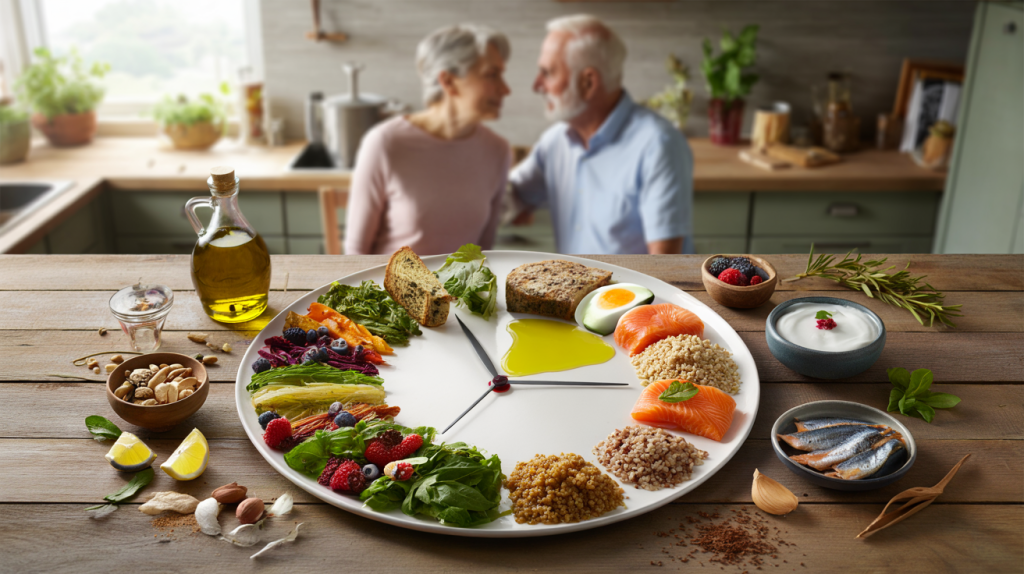Looking for an anti-aging diet that actually changes something in the mirror and not just on the label. Here’s the deal : several big studies have tracked what people eat, how they age, and who stays healthier longer.
Results have converged. A Mediterranean-style pattern cut major cardiovascular events by about 30 percent in high-risk adults (NEJM, 2013). Eating 25 to 29 g of fiber per day linked to 15 to 30 percent lower all-cause mortality and chronic disease incidence across 185 studies and 58 trials (Lancet, 2019). Every 10 percent increase in ultra-processed foods tied to a 14 percent higher mortality risk (BMJ, 2019). Calorie restriction over two years slowed the biological pace of aging by roughly 2 to 3 percent in healthy adults (JAMA Network Open, 2023). That is the backbone of a real anti-aging plate.
Anti-aging diet, defined by evidence
The core idea stays simple : mostly plants, high-fiber carbs, quality protein for muscle, and fats from extra-virgin olive oil, nuts, and fish. This pattern has repeatedly aligned with slower disease and better function with age.
Muscle needs rise with birthdays. Expert groups suggest older adults target around 1.0 to 1.2 g of protein per kilogram per day to maintain strength and independence (ESPEN, 2018). Omega-3 rich fish one to two times weekly supports heart and brain health across large cohorts (AHA, 2021). Polyphenol-rich foods like berries, olive oil, cocoa, and leafy greens have been associated with longer telomeres and healthier aging trajectories in observational data (BMJ, 2014).
Zoom out and the pattern repeats : whole foods correlate with longer healthspan, while ultra-processed products push in the opposite direction. Not magic. Just consistent signals from cohorts and randomized trials.
Daily plate: what to eat and what to limit
To turn the science into routine, build meals around plants, then layer protein and smart fats. Small tweaks compound fast.
- Fill half the plate with vegetables and berries for fiber and polyphenols.
- Choose intact carbs : oats, quinoa, brown rice, rye, or wholegrain sourdough.
- Hit protein targets with fish, eggs, tofu, lentils, yogurt, or poultry.
- Make extra-virgin olive oil the default fat and add a daily handful of nuts, about 30 g as in the NEJM trial.
- Eat fish 1 to 2 times per week, oily options like salmon, sardines, or mackerel.
- Keep added sugars under 10 percent of total energy, ideally closer to 5 percent (WHO, 2015).
- Cut ultra-processed items that combine refined starches, added sugars, and additives most days.
That single list covers most of the anti-aging effect observed in the literature. It also leaves room for real life and favorite flavors.
Common mistakes that age you faster
Under-eating protein while trying to “eat light”. This quietly accelerates muscle loss. Practical fix : include 20 to 30 g protein at each main meal and pair it with resistance work for better results (ESPEN, 2018).
Swapping whole carbs for sugary, low-fiber snacks. The 2019 Lancet analysis linked higher fiber with lower mortality and incident disease. Translation : trade cookies for fruit and nuts, white rice for brown or barley, sweetened yogurt for plain with berries.
Letting ultra-processed foods creep in daily. In the French NutriNet-Santé cohort, each 10 percent higher share of ultra-processed foods in the diet associated with a 14 percent higher all-cause mortality risk (BMJ, 2019). Reading labels for short, familiar ingredients helps.
Thinking “low-fat” is always better. The Mediterranean pattern improved outcomes using olive oil and nuts, not by stripping fat. Quality beats quantity, and satiety improves, which makes change stick (NEJM, 2013).
Make it stick: an easy 7-day rhythm
Start with anchors. Two fish dinners in the week. Beans or lentils on four days. A daily 30 g nut portion. Olive oil on salads and vegetables. That’s the scaffold.
Breakfast ideas rotate fast : oatmeal with berries and yogurt, veggie omelet with rye toast, or chia pudding with kiwi. Lunch keeps it simple : grain bowl with greens, chickpeas, seeds, and olive oil, or leftover salmon with quinoa and tomatoes. Dinner swings between lentil soup with carrots and celery, roasted vegetables with tofu, or wholewheat pasta tossed with olive oil, garlic, spinach, and walnuts.
Keep a 12-hour overnight eating window when it fits the day. Many people find energy and digestion improve, and calorie restriction trials suggest a modest slowing of biological aging with sustained, safe energy reduction over time (JAMA Network Open, 2023). Not a rule, just a tool.
Shop once for the base : big bag of greens, frozen berries, canned beans, whole grains, eggs, a liter of extra-virgin olive oil, plain yogurt, tins of sardines, a mix of nuts. Prep two trays of roasted vegetables on Sunday. Make a pot of lentils midweek. These low-effort moves definitley lower friction.
Small note on taste and joy. Herbs, citrus zest, garlic, tahini, and good vinegar transform the same ingredients into very different meals. When food is craveable, the anti-aging pattern stops feeling like a plan and starts looking like a lifestyle you actually keep.
Sources : NEJM 2013 PREDIMED trial; Lancet 2019 fiber umbrella review; BMJ 2019 NutriNet-Santé cohort; WHO 2015 sugars guideline; ESPEN 2018 protein guidance for older adults; AHA 2021 seafood advisory; JAMA Network Open 2023 caloric restriction and biological aging.
